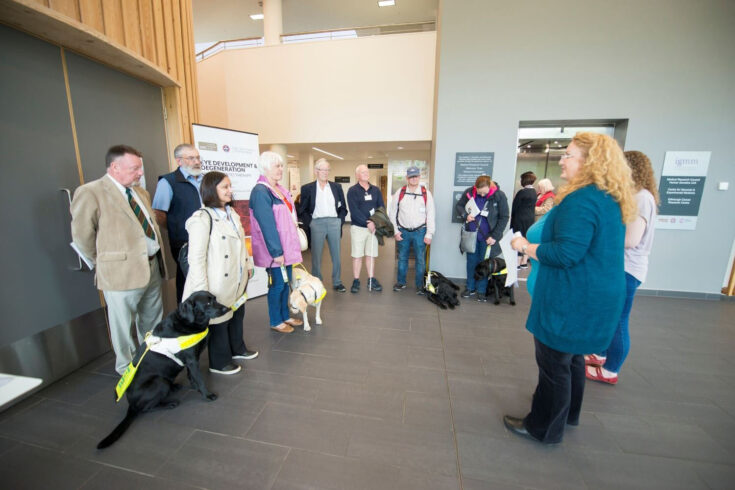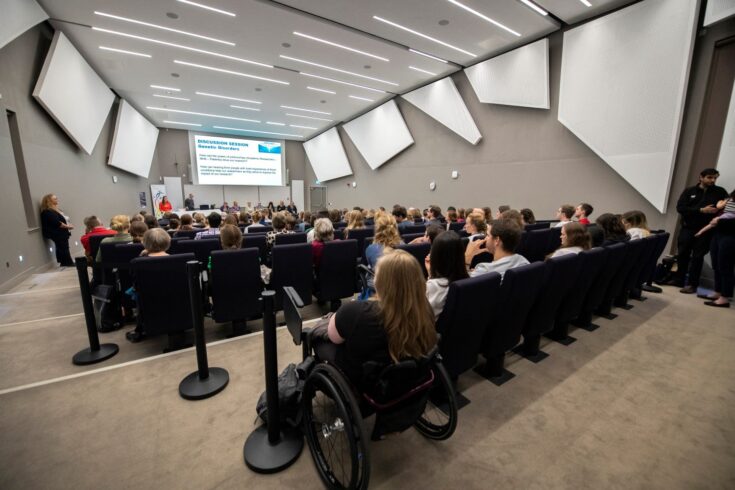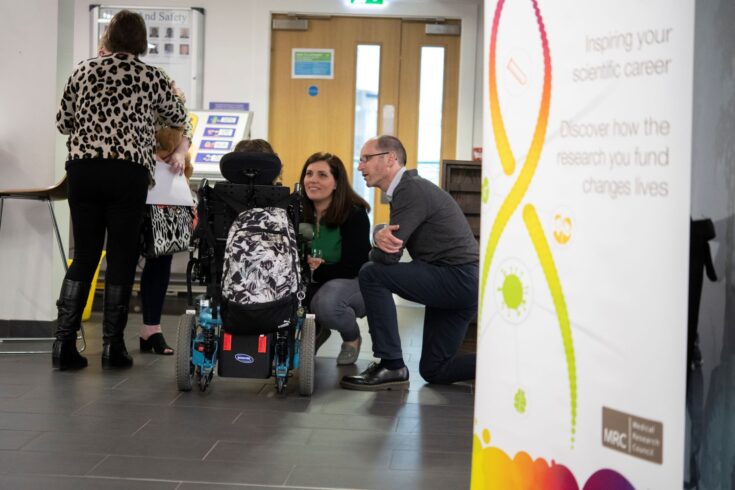How the leadership of a research unit embedded a culture of public involvement to help staff include patients’ voices in their research.
By Professor Wendy Bickmore, Director of the Medical Research Council Human Genetics Unit at The University of Edinburgh
We’ve always recognised the importance of patient involvement in our work at the Medical Research Council Human Genetics Unit (MRC HGU). But over the past 10 years we’ve evolved a culture of public involvement. We’ve built the foundation, raised awareness of how to involve the patient voice and increased the professional support available to researchers.
Involving public voices
At the unit we have a very strong focus on rare genetic disease. It’s often quite small groups of individuals living with those conditions.
There’s a real burning desire from them to hear about research on their condition, to be involved and possibly to shape it in the future. I think that immediately gives us a very personal link to people, particularly in Edinburgh.
Our public engagement and involvement strategy is intended to support progression from ad hoc researcher conversations with patients and patient advocates, to fully involving specific individuals in our research.
We have purposefully connected with individuals and groups who have a stake in the outcomes of our research through events and activities focused on the specific conditions we research.
An early example was holding a patient group event linked to a scientific meeting on genetic eye disease. A more advanced example is where people with lived experience have contributed to the design, governance and delivery of DecodeME, our myalgic encephalomyelitis/chronic fatigue syndrome research study.
We’ve seen a step change, in that our staff now have more of an idea of what’s considered best practice for public involvement and how to go about it. They’ve seen inspiring examples of how it can work.
It’s now more embedded into our strategic thinking and our written strategy. The need for involvement is part of our leadership thinking in a way that it wasn’t 10 years ago.
Activities we have run

Patient delegates and service animals gather to tour scientific facilities at a 2017 eye development and degeneration conference hosted by the MRC Human Genetics Unit. Credit Craig Nicol
In 2017 we hosted an eye conference for international researchers. We welcomed people living with genetic eye conditions to part of the meeting, some with their guide dogs. Everyone had a great day, but it was a learning experience for us on risk assessments, accessibility planning and good practice.
For example, we had not specifically asked how many of our visitors would be bringing support animals and had to adapt our planning to account for the presence of multiple dogs. This impacted laboratory tour plans, as dogs could not be included in a zebrafish facility tour.
We adapted the visit for those individuals by verbally explaining how we use zebrafish in our vision research. We also had to rearrange seating to avoid chaos due to having so many dogs in one room, as well as provide water for the dogs on a hot day.
During a panel session at the conference, featuring researchers and people with genetic eye conditions, it was brilliant to see a conversation of equals around research. That got us thinking, how do we enable more of our staff and students to hear the patient voice?
From ad hoc activities to strategic planning

Patient, advocate and researcher panel discussion during the ‘Shining a light on rare genetic disease’ event at the MRC Human Genetics Unit in 2019. Credit Connor Warnock
We organised an internal event called ‘Shining a light on rare genetic disease’, for all our staff and students. We invited two parents of children affected by a rare genetic disease to tell us about their family’s journey to diagnosis.
The event was very emotive and powerful. Our staff, including administrative staff, felt it was very motivating and helped them understand the ultimate purpose of our research. After this, we recognised that we needed more support to encourage our researchers to involve patient voices.
In 2017 we recruited a part-time, dedicated public engagement manager. In the past we had combined communications and public engagement in one role. I think that reflects a key point of evolution of our strategy, moving from ad hoc activities to strategic planning.
Regular series of public events

Professors Yanick Crow and Dr Caroline Uggenti talk to a participant at the ‘Shining a light on rare genetic disease’ event. Credit Connor Warnock
We started running the ‘Shining a light on’ events as a regular series. These public events bring together our researchers with anyone who’s interested in or affected by a specific condition. They feature a researcher, a patient and sometimes another representative from a patient group, discussing the condition, the challenges and the needs.
We usually then hold a poster session and separate meeting with the researcher and the patients or representatives, enabling an exchange of ideas. We carefully prepare our researchers to ensure the material they present is clear and accessible.
This series of events has helped us listen to different voices and at the same time forge new relationships and to find common interests. The use of online and hybrid formats has been very helpful, especially for rare disease where local attendance would greatly restrict reach.
A common message from these conversations is that for genetic diagnosis, it’s not just about the research, the genes and the tests. It’s how to get tests into the healthcare system.
Building connections and awareness
For non-clinical academics focused on a particular health condition we aim to make connections with patients through relevant patient organisations. We collaborate with not-for-profit organisations like Genetic Alliance and the Primary Ciliary Dyskinesia Foundation.
We also give advice to our staff on how to incorporate public involvement into the research process, for example a funding bid or how to consult at an early stage. Fortunately, The University of Edinburgh has an expert who helps us deliver training, including recent open-to-all training sessions delivered with our public engagement manager.
Impact of public involvement
Reinforced the need for our research
Hearing the patient voice has reinforced to us the need for our research, for example quicker diagnosis for rare genetic diseases. At one of our events, some of us were horrified to hear from patients how long it can take for a child with a severe disorder to get diagnosed. It inspires everybody that what they’re doing matters and reminds them of the impact on individuals.
Shown the power of combining voices
In 2024 we hosted an international event on rare disease day, which usually takes place at the Scottish Parliament. It was attended by politicians, NHS staff, patients and researchers, both clinical and non-clinical.
There was a good discussion about how to move genetic medicine services forward in Scotland and what the issues were. We felt the patients and the researchers were really speaking with one voice, helping to move policy forward.
Built staff expertise and enthusiasm
Through our regular events we’re building up staff awareness, expertise and experience. We’ve inspired people’s enthusiasm and ideas for engaging and involving the public with their own research, supported by our public engagement manager.
Benefited our staff and our research
Dialogue with the public has a positive ripple effect on our research community.
Researchers sharpen their listening and communication skills, gain knowledge of the landscape of a condition, as well as focus and motivation, and generate new research ideas.
Brought patients a better understanding of disease
Being heard and believed, and having a name for a condition, is important. It’s critical to patients and their families to have a diagnosis, and to understand what that means for them, or for their child and their development.
Improved patient care
When researchers work together with families, they can improve patient care. Families affected by Cornelia De Lange syndrome told our clinicians and researchers they were struggling to explain it in hospital.
This is a rare condition that affects growth and development, and is associated with other medical conditions. So together they created a small card explaining the condition, to support patients through their care journey. It was such a simple thing, but very effective.
Lessons learned
Take the first step and learn from it
Evolve something that works for you and build the training and the confidence of your staff and students.
All the patient groups that we’ve interacted with are open to talking about their condition and being extraordinarily frank about what it’s like. Not only to live with the condition, but also to look after children who are affected by very severe conditions. Even if you’re not directly working on a cure for a disease, people will be interested and have a view.
Seek relationships and build trust
Some of those relationships are with patients and organisations. Some are the support you can access within your organisation or from others. I think relationship-building is important, because then you get the chance to start listening, learning and building trust.
Seek professional support
Researchers need someone to help them navigate public involvement. There’s no ‘one size fits all’ approach. Professional support is important to help researchers understand their situation, what they can do and what they need to consider.
Last updated: 10 October 2024
